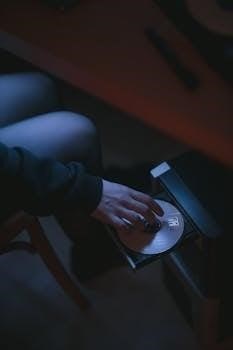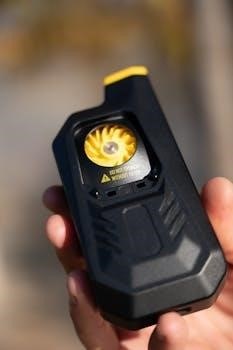The Boss RC-30 is a pedal-type recorder designed for musicians to record audio phrases from instruments or vocals. It allows real-time layering and playback, enabling a wide range of performance possibilities. This dual track looper is a powerful tool for creative sound exploration.
Overview of the RC-30 Functionality
The RC-30 is a versatile loop station that empowers musicians with its ability to record and layer audio phrases in real-time. It allows users to capture sounds from instruments like guitars or vocals, providing a platform for creative exploration. This pedal facilitates the creation of complex musical arrangements through its dual track looping capabilities. Users can record and playback phrases, building up intricate layers of sound. The RC-30 also provides features for seamless transitions and creative looping techniques, making it a powerful tool for live performances and studio work, offering intuitive controls for a fluid workflow.
Key Features of the RC-30
The RC-30 boasts dual track looping, enabling simultaneous recording on two separate tracks. It also allows for real-time layering and playback, expanding creative performance capabilities. This makes it a powerful tool.
Dual Track Looping Capabilities
The Boss RC-30 features the ability to record on two separate stereo tracks, allowing users to create more complex and layered loops. This dual-track functionality enables musicians to build rich, textured soundscapes by recording different musical phrases or parts on each track. You can switch between these two recording tracks seamlessly during live performances or when composing. This provides a platform for dynamic and varied compositions, adding depth to the overall sound by allowing independent manipulation of each recorded loop. The dual-track design is a core feature of the RC-30’s power.
Real-Time Layering and Playback
The RC-30 allows for real-time layering of audio phrases, enabling performers to build complex arrangements on the fly. This feature lets you record a base loop and then add layers on top of it as the loop continues to play, creating intricate and evolving soundscapes. The playback is also in real-time, ensuring that each added layer integrates seamlessly with existing parts, enhancing the dynamic nature of live performances and studio creations. This instant responsiveness is ideal for creating spontaneous and unique musical expressions, and is a key element in how the RC-30 encourages creativity.

Powering the RC-30
The RC-30 can be powered by a 9V power adapter or via six AA batteries. This dual power option provides flexibility for both studio and on-the-go use. It is essential to use the correct power specifications.
Power Adapter Requirements
The Boss RC-30 requires a 9V DC power adapter to operate when not using batteries. It’s important to ensure that the adapter provides the correct voltage and current to avoid damaging the unit. The pedal needs 120mA for proper function, which is a key detail to note. Using an incorrect adapter can lead to power issues or even damage. Always double-check the specifications of your power adapter before plugging it into the RC-30. Using the correct power supply is critical for reliable and consistent performance.
Battery Operation and Type
The Boss RC-30 can also be powered by six AA batteries, offering portability and convenient use without needing a power adapter. This makes it perfect for rehearsals, outdoor performances, or when a power outlet isn’t available. It’s important to note that using batteries can impact the unit’s performance over time as the batteries drain, so it is important to have fresh batteries. The original box includes a set of these AA batteries, ready to get started. Always make sure to use the correct type of batteries for optimal performance and to prevent damage.
Inputs and Connections
The RC-30 features multiple input options including a mic input, an instrument input, and an aux input. Each input is designed for specific signal levels, ensuring optimal recording quality.
Mic Input Specifications
The RC-30’s microphone input is designed to accommodate a variety of microphones, with a nominal input level of -40 dBu, which is variable. This input offers a 4 k ohms input impedance, ensuring compatibility with common microphone types. It allows for the recording of vocals or acoustic instruments directly into the loop station. The variable input level enables users to adjust the gain for different microphone sensitivities, ensuring a clean and clear recording signal. This feature makes the RC-30 versatile for diverse recording scenarios.
Instrument Input Specifications
The instrument input on the RC-30 is engineered for optimal performance with guitars and other similar instruments. It features a nominal input level of -20 dBu, providing a suitable signal range for most instrument pickups. The input impedance is set at 1 M ohm, designed to preserve the natural tone and dynamics of your instrument. This high impedance ensures minimal signal loss and maintains clarity, making it ideal for both electric and acoustic instruments. The instrument input is crucial for creating layered loops with a wide range of instruments.
Aux Input Specifications
The auxiliary input on the RC-30 is designed to accommodate various external audio sources, providing a convenient way to incorporate backing tracks or other pre-recorded material into your loops. This input has a nominal level of -10 dBu, making it compatible with devices such as smartphones, mp3 players, and other line-level audio sources. The specific input impedance is not explicitly mentioned, however, it is suitable for connecting devices with standard line-level outputs. This flexibility makes the RC-30 a versatile tool for solo performers and those experimenting with diverse soundscapes, allowing seamless integration of external audio.

Basic Operation and Controls
The RC-30 features intuitive controls for recording and playback. It includes memory up/down buttons for selecting phrases and a simple pedal mode for streamlined looping. These basic functions help users quickly learn to use the device.
Using the Memory Up/Down Buttons
The memory up and down buttons on the RC-30 are essential for navigating through the different recorded phrases stored within the device. By pressing the “Memory Up” button, you advance to the next memory location containing a recorded loop, while the “Memory Down” button allows you to return to the previous memory slot. These buttons enable seamless transitions between saved loop phrases, making them perfect for live performances. It’s important to note that these button controls determine which loop is currently active for playback and recording, and allow the user to quickly access different recorded loops.
Simple Pedal Mode Feature
The Simple Pedal Mode on the RC-30, sometimes overlooked, streamlines the looping process by assigning key functions to the footswitches. This mode simplifies operation, allowing for quick recording, playback, and overdubbing with fewer button presses. It focuses on basic looping tasks, making it very useful for beginners or for those who prefer a more hands-free approach. This feature is not always immediately obvious, as it was included on a separate sheet of paper rather than the main manual. Simple Pedal Mode enhances the user experience by providing an alternative control scheme for basic loop functionalities.

Additional Resources and Support
Users can access the official user manual and BOSS TONE CENTRAL for extra content. These resources provide detailed instructions and additional sounds to enhance the RC-30 experience.
Accessing the Official User Manual
The official user manual for the BOSS RC-30 is readily available online, typically in PDF format. You can often find it on the official BOSS website under the support section for the RC-30 product. It provides detailed information on all aspects of the device, including its functions, features, and operational procedures. This manual is a crucial resource for both new users and experienced loopers to fully understand the capabilities and proper use of the RC-30. The manual can also be found through various third-party websites, but ensure you are downloading from a reliable source.
BOSS TONE CENTRAL Content
BOSS TONE CENTRAL provides an extensive library of additional content for BOSS products, including the RC-30. By using the BOSS TONE STUDIO application and connecting to the internet, users can access a growing collection of free content. This content may include patches, settings, and other resources that enhance the functionality of the RC-30. It serves as a valuable tool for users who are looking to expand their creative options and take their looping to the next level. The platform offers an easy way to discover new sounds and performance techniques specifically designed for the RC-30.

Troubleshooting Common Issues
Users encountering issues with their RC-30 can find solutions to common problems, like power issues, through online resources. Support forums and user communities provide additional help.
Addressing Power On Problems
If your Boss RC-30 fails to power on, begin by verifying the power adapter is correctly connected and functioning. Ensure that the adapter meets the 9V, 120mA requirements. Alternatively, if using batteries, confirm they are correctly installed and have sufficient charge. The RC-30 uses six AA batteries. If issues persist, consider testing a different power source or consulting online forums for user-reported solutions. Some users have reported issues with power even when connected correctly, and there can be other possible factors involved such as a faulty adapter or a problem with the pedal itself.
Finding Additional Support and Forums
For further assistance with your Boss RC-30, explore online resources such as the official BOSS website, which offers product manuals and support documentation. The Gear Page, a leading online community, may also provide helpful discussions and user experiences. Additionally, forums dedicated to guitar effects and looping can offer specific advice from experienced users. Look for the official manual on the Boss website, as well as tutorial videos that may help troubleshoot. These communities often have threads dedicated to the RC-30 where users share solutions and offer advice. Remember to check BOSS TONE CENTRAL for additional content related to the RC-30.
